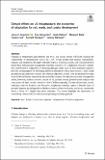Climate effects on US infrastructure: the economics of adaptation for rail, roads, and coastal development
Author(s)
Neumann, James E.; Chinowsky, Paul; Helman, Jacob; Black, Margaret; Fant, Charles; Strzepek, Kenneth; Martinich, Jeremy; ... Show more Show less
Download10584_2021_Article_3179.pdf (2.673Mb)
Publisher with Creative Commons License
Publisher with Creative Commons License
Creative Commons Attribution
Terms of use
Metadata
Show full item recordAbstract
Abstract
Changes in temperature, precipitation, sea level, and coastal storms will likely increase the vulnerability of infrastructure across the USA. Using models that analyze vulnerability, impacts, and adaptation, this paper estimates impacts to railroad, roads, and coastal properties under three infrastructure management response scenarios: No Adaptation; Reactive Adaptation, and Proactive Adaptation. Comparing damages under each of these potential responses provides strong support for facilitating effective adaptation in these three sectors. Under a high greenhouse gas emissions scenario and without adaptation, overall costs are projected to range in the $100s of billions annually by the end of this century. The first (reactive) tier of adaptation action, however, reduces costs by a factor of 10, and the second (proactive) tier reduces total costs across all three sectors to the low $10s of billions annually. For the rail and road sectors, estimated costs for Reactive and Proactive Adaptation scenarios capture a broader share of potential impacts, including selected indirect costs to rail and road users, and so are consistently about a factor of 2 higher than prior estimates. The results highlight the importance of considering climate risks in infrastructure planning and management.
Date issued
2021-08-19Department
Massachusetts Institute of Technology. Center for Global Change SciencePublisher
Springer Netherlands
Citation
Climatic Change. 2021 Aug 19;167(3-4):44
Version: Final published version